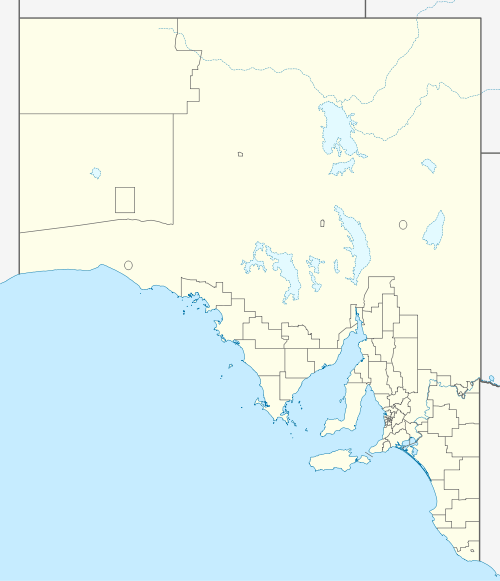Aldinga Scrub Conservation Park
Aldinga Scrub Conservation Park is a protected area in the Australian state of South Australia located in the suburb of Aldinga Beach about 46 kilometres (29 miles) south by west of the state capital of Adelaide.[1]
| Aldinga Scrub Conservation Park Aldinga Beach[1], South Australia | |
|---|---|
IUCN category III (natural monument or feature)[2] | |
Reserve as viewed from Seagull Street, Aldinga Beach | |
 Aldinga Scrub Conservation Park | |
| Nearest town or city | Adelaide |
| Coordinates | 35°17′43″S 138°27′16″E[1] |
| Established | 7 November 1985[3] |
| Area | 2.66 km2 (1.0 sq mi)[4] |
| Managing authorities | Department for Environment and Water |
| Website | Aldinga Scrub Conservation Park |
| See also | Protected areas of South Australia |
The conservation park consists of land in the cadastral unit of the Hundred of Willunga consisting of section 821 and land identified as allotments 4, 14, 15 and 100. It came into existence on 7 November 1985 by proclamation under the National Parks and Wildlife Act 1972 in respect to section 821. The remainder of the land holding was proclaimed on 14 March 1991.[3][5] As of 2016, it covered an area of 2.66 hectares (6.6 acres). [4]
The conservation park was proclaimed for the purpose of protecting a parcel of undeveloped land considered to be 'a significant remnant of the natural habitat that once occurred all along the southern Adelaide coastline'. [6]
It is positioned in the Willunga sub-basin and is characterised by a backdrop of sand dunes, sand blows and small coastal vegetation. The Park consists of an extensive range of rare plants and is considered as an important region for the conservation of flora and fauna. Some of the rare plants include Lacy coral lichen, nardoo, hairy sedge and various species of orchids. Short-beaked echidnas, lizards, bats and several birds form a part of its ecosystem.[7]
The conservation park is a part of the region which was inhabited by the Kaurna aboriginal people and the first European settler, Mr F Culley arrived here in 1857. Much effort was made to farm on the land before the World War I, but they all proved futile. The Willunga Council feared that the area may cause erosion and thus 300 hectares were purchased to be supervised by the State Planning Authority as an Open Space Reserve.[8]
The conservation park is classified as an IUCN Category III protected area.[2]
See also
References
- "Search for "Aldinga Scrub Conservation Park" with the following datasets selected - 'NPW and Conservation Properties', 'Suburbs and Localities' and 'Gazetteer'". Location SA Map Viewer. Government of South Australia. Retrieved 13 March 2020.
- "Terrestrial Protected Areas of South Australia (refer 'DETAIL' tab )". CAPAD 2016. Australian Government, Department of the Environment (DoE). 2016. Retrieved 21 February 2018.
- Slater, John W. (7 November 1985). "NATIONAL PARKS AND WILDLIFE ACT, 1972: SECTION 30—ALDINGA SCRUB CONSERVATION PARK CONSTITUTED" (PDF). The South Australian Government Gazette. Government of South Australia. p. 1362. Retrieved 10 January 2019.
- "Protected Areas Information System - reserve list (as of 17 Feb 2014)" (PDF). Department of Environment Water and Natural Resources. Retrieved 26 March 2014.
- Gregory, R. J. (14 March 1991). "NATIONAL PARKS AND WILDLIFE ACT 1972 SECTION 30 (2): ALDINGA SCRUB CONSERVATION PARK, ALTERATION OF BOUNDARIES" (PDF). The South Australian Government Gazette. Government of South Australia. p. 854. Retrieved 14 March 2020.
- South Australia. Department of Environment and Planning Far West District; South Australia. National Parks and Wildlife Service (1992), Aldinga Scrub Conservation Park management plan, Southern Metropolitan Adelaide, South Australia (PDF), Dept. of Environment and Planning, p. 5
- "Aldinga Scrub Conservation Park". National Parks South Australia.
- "European history". National Parks and Wildlife Service South Australia.
External links
- Official webpage
- Friends of Aldinga Scrub
- Webpage on the BirdsSA website
- Webpage on the Protected Planet website